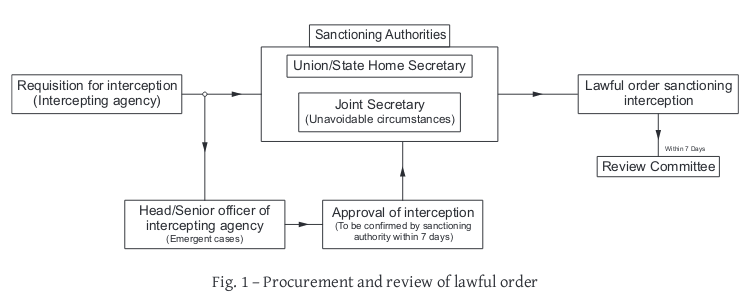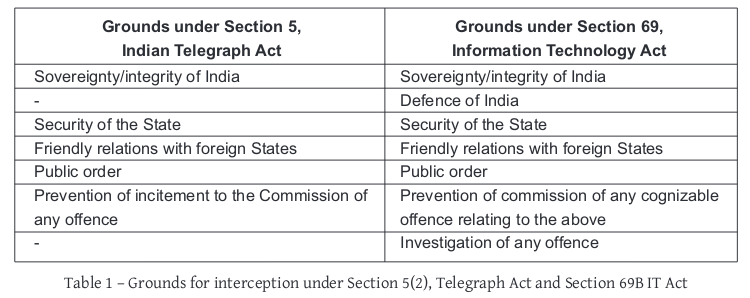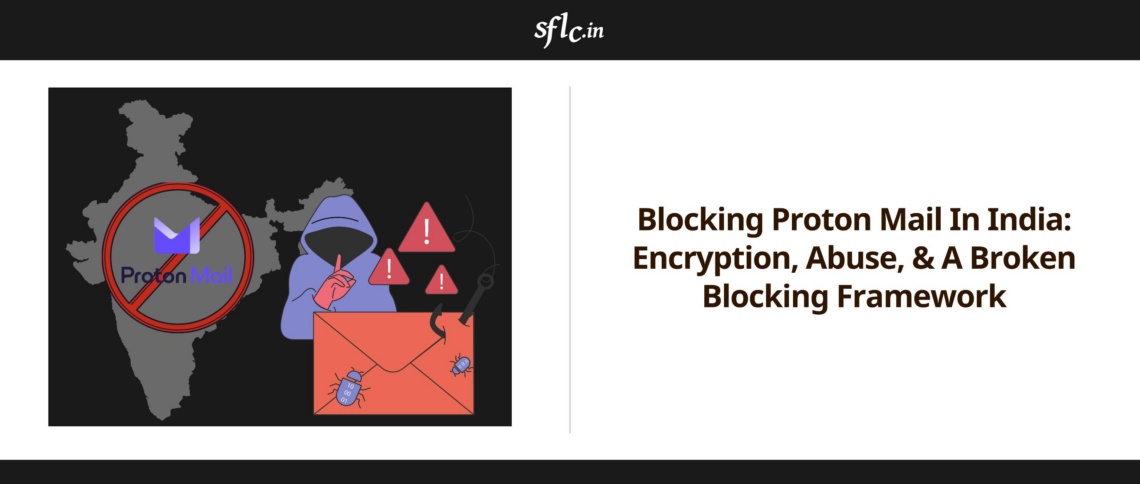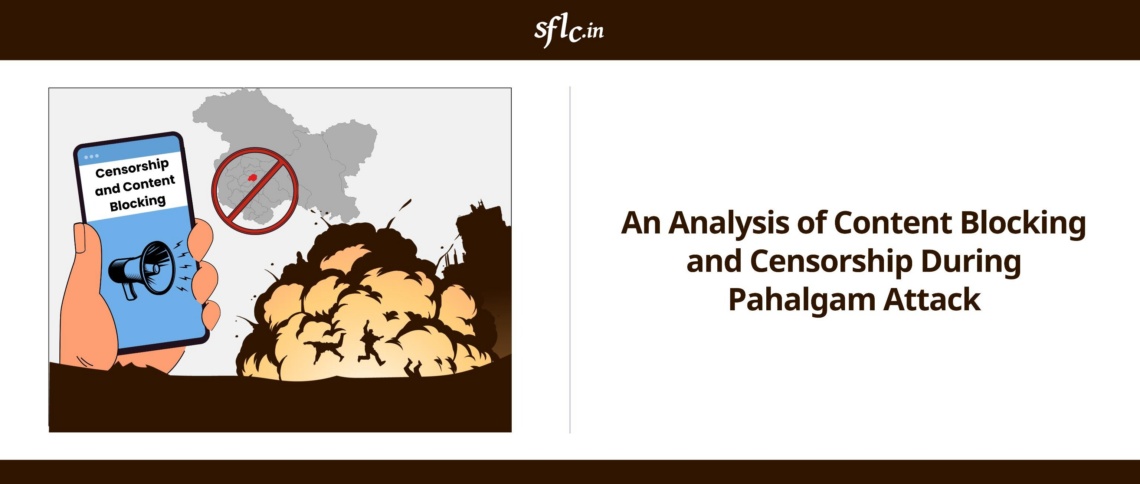What exactly is surveillance?
The Merrian – Webster dictionary defines surveillance as “keeping a close watch kept on someone or something”. In the context of this FAQ we refer to the word ‘surveillance’ only to the act of real-time surveillance conducted by Governments through telecommunication systems (namely, telephones and the Internet), though private actors may also conduct surveillance through various methods and offline methods are also used by governments to conduct surveillance.
Is there a way that survellience can happen offline as well?
Yes, Section 26 of the Indian Post Office Act, 1898 gives the government the power to intercept articles for public good. It has been mentioned in the section that when there is an occurrence of a public emergency or in the interest of public safety/tranquility an authorized officer of either the state or the central government by making an order in writing can intercept, detain or dispose of any kind of postal article. The subsection (2) of the section mentions that when there is unsurity of if the interception/detention or disposing off was done in public interest, a certificate issued by the government will be conclusive proof. However, for the purpose of this article, we will not be diving into details of offline surveillance.
Is suveillance in India legal?
Yes, as there exists a legal framework which enables the Government to conduct surveillance on the occurrence of certain circumstances. However, the surveillance has to be undertaken within the boundaries of this legal framework.
Which are the laws that regulate surveillance conducted by the government?
Telephones
1. The Indian Telegraph Act, 1885
- Section 3(1AA): Defines what a ‘telegraph’ is and means, “…any appliance, instrument, material or apparatus used or capable of use for transmission or reception of signs, signals, writing, images, and sounds or intelligence of any nature by wire, visual or other electro-magnetic emissions, Radio waves or Hertzian waves, galvanic, electric or magnetic means…”
-
Section 5(2): This section is invoked to conduct surveillance over telegraph lines (as defined above, but with the occurence and condition of the pre-requisites of a public emergency or the interest of public safety.
2. Indian Telegraph Rules, 1951
- Rule 419A: This provision lays down the procedural law regarding telephone tapping. It was introduced by way of an amendment in 2007, which was necessitated by the Supreme Court’s condemnation in the case People’s Union for Civil Liberties v. Union of India (AIR 1997 SC 568) of the lack of procedure governing telephone tapping. The provision mandates that telephone tapping can be done only through a lawful order.

Internet
Provisions dealing with Internet surveillance may be found interspersed throughout the Information Technology Act 2000 and several rules made thereunder.
1. Information Technology Act, 2000

- Section 69: Modeled extensively after Section 5(2) of the Telegraph Act, allows the Government to engage in surveillance of Internet data. However, there exists no pre- requisites for the invocation of Section 69 when compared with Section 5(2) of the Indian Telegraph Act, 1885 and has enlarged grounds.>
- Section 69B: This provision in turn deals with the surveillance of Internet metadata as compared to Internet data. Metadata is any data that gives information about other data. For example, if person A sends a message to person B, then the content of the message will be data and the data such as the time and date of sending and receiving the message, information about the devices from which the message was sent and received, profile information, etc. would be the metadata.
2. Information Technology (Procedure and Safeguards for Interception, Monitoring and Decryption of Information) Rules, 2009
These rules lay down the provision for the procedural law related to the Internet-data surveillance conducted under Section 69 of the Information Technology Act.
3. Information Technology (Procedure and Safeguards for Monitoring and Collecting Traffic Data or Information) Rules, 2009
These rules lay down the provision for the procedural law related to the Internet-data surveillance conducted under Section 69B of the Information Technology Act.
Under both the above Rules, the procedure laid down is substantially similar to the procedure laid down in Rule 419A of the Indian Telegraph Rules, 1951.
In addition to these laws, license agreements such as the Unified Access Service License (UASL), Internet Service License (ISL), and the Unified License (UL) which incorporates the former two licenses between the Department of Telecommunications and telecommunications service providers also enable the government to receive assistance from telecommunication service providers in conducting surveillance. Licensees must also provide in the interests of security, ‘suitable monitoring equipment as per the requirement of the DOT or law enforcement agencies.
Are there any monitoring systems in place in India?
As per available information, the Central Monitoring System (CMS) and the National Intelligence Grid (NATGRID) are the two intelligence systems in place in India. Also, another system named Network Traffic Analysis (NETRA) was rumoured to be launched in 2014. NETRA was developed by the Centre for Artificial Intelligence and Robotics (CAIR), a lab under the Defense Research and Development Organisation (DRDO). However, not much information is available regarding the project.
In additions to such dedicated systems, state police forces also conduct monitoring of social media platforms and the web. For example, the Mumbai police force monitored social media platforms to tackle fake news surrounding the Maharashtra elections and similarly, the Uttar Pradesh police force has been put on ‘high alert’ in anticipation of the Ayodhya verdict and as part of vigilance, is conducting social media monitoring. However, this is purely not ‘backdoor’ surveillance but a scan and analysis of publicly available social media posts.
Which are the government agencies involved or carry out surveillance in India?
In a starred question which was raised in the Lok Sabha and answered on 11.02.2014, the names of the agencies authorised to intercept and collect details of telephonic conversations under Section 5(2) of the Indian Telegraph Act, 1885 read with Rule 419A of Indian Telegraph (Amendment) Rules, 2007. were listed as follows:
# Central Agencies
-
Intelligence Bureau
-
Narcotics Control Bureau
-
Directorate of Enforcement
-
Central Board of Direct Taxes
-
Directorate of Revenue Intelligence
-
Central Bureau of Investigation
-
National Investigation Agency
-
Research & Analysis Wing (R&AW)
-
Directorate of Signal Intelligence, Ministry of Defence – for Jammu & Kashmir, North East & Assam Service Areas only
# State Agencies
-
Director General of Police, of concerned state/Commissioner of Police, Delhi for Delhi Metro City Service Area only
As per the order of the Ministry of Home Affairs S.O. 6227(E) dated 20.12.2018 the following Security and Intelligence Agences were authorised “for the purposes of interception, monitoring and decryption of any information generated, transmitted, received or stored in any computer resource under the Sub-section 69 (1) of the Information Technology Act, 2000 (21 of 2000) read with rule 4 of the Information Technology (Procedure and Safeguards for Interception, Monitoring and Decryption of Information) Rules, 2009
-
Intelligence Bureau
-
Narcotics Control Bureau
-
Enforcement Directorate
-
Central Board of Direct Taxes
-
Directorate of Revenue Intelligence
-
Central Bureau of Investigation
-
National Investigation Agency
-
Cabinet Secretariat (RAW)
-
Directorate of Signal Intelligence (For service areas of Jammu & Kashmir, North-East and Assam only)
-
Commissioner of Police, Delhi
What is the remedy available in case you suspect that you have been placed under surveillance illegaly, for example the WhatsApp-NSO scandal?
Judicial recourse is obviously the effective remedy available for negating unlawful monitoring/surveillance efforts by the Government. Illegal monitoring methods, such as the one employed in the WhatsApp-NSO Spyware employs malicious hacking (also known has black-hat hacking) methods which amount to violation of Sections 43 and 66 of the Information Technology Act, 2000, which ascribes liability on the perpetrator of the crime.
Section 43
Section 43 of the Information Technology Act, 2000 deals with penalties and compensation for damage to computer, computer system etc. Section 43 ascribes civil liability to anyone who causes any damage to a computer or a computer system and demands the actor to pay damages (compensation) to the affected person.
Section 66
Section 66 deals with computer related offences. If any person, dishonestly or fraudulently, does any act referred to in Section 43, he shall be punishable with imprisonment for a term which may extend to three years or with fine which may extend to five lakh rupees or with both. Section 66 ascribes criminal liability onto the prepetrator of a cyber crime.
How can I approach forums for securing a remedy?
1. Approaching Cyber Cells
All state police forces have a cybercrime division or a cyber cell or a dedicated cybercrime police station established where victims of cybercrimes can file complaints in case of a malicious cyber incident. First Information Reports can be filed under S. 154 of the Criminal Procedure Code, 1973 in case you are a victim of a cyber crime such as malicious hacking.
It is advised to provide as much information as you can while filing such complaints, including information regarding application and system logs, IP addresses, relevant screenshots. It would be wise to approach a cyber security expert or a digital forensics examiner if you are unaware of how to retrieve necessary information.
2. Approaching Magistrate Courts
If under any circumstances, the police officer/cell refuses to receive or investigate your complaint, recourse may be taken by approaching the Magistrate court through Section 156 (3) read with Section 190 of the Criminal Procedure Code, 1973 by filing a private complaint and seek a direction to the police station concerned to investigate the matter (called a ‘forwarding petition’).
3. Approaching the High Courts
If you suspect that you are being placed under surveillance through an illegal order in contravention to Section 5(2) of the Indian Telegraph Act, 1955 and Rule 419A of the Indian Telegraph Rules, 1951, or under Section 69 of the Information Technology Act, 2000, you can approach the appropriate state High Court under Article 226 of the Constitution of India invoking the ‘writ’ jurisdiction of the High Court to quash the illegal surveillance order and also for exemplary compensation. It is advisable to obtain relevant information regarding the surveillance order by filing RTI applications.
If you suspect that you are a victim of the WhatsApp-NSO Spyware row, then you can approach the High Court if your name has been revealed in any list released by Citizen Lab or any other publicly reported list.
What if the Information Officer under the State/Central authority refuses to furnish information your RTI Application is rejected citing exemptions under Section 8 of the Right to Information Act, 2005 or is delayed?
Under the RTI Act, application for information maybe refused to be furnished citing exemption from disclosure under different grounds enumerated in Section 8 of the Act (and also Section 9 if it infringes copyright of a person other than the State).
Normally, information sought by an application under the RTI Act, has to be furnished within 30 days from the receipt of the application by the public authority and if the information sought for by the applicant is concerned with the life and liberty of a person, it is to be provided within 48 (forty-eight) hours.
If any of the above is a case concerning your application or if you are not satisfied with the information supplied to you, you can still raise an appeal (within 30 days) to the first appellate authority (who is an officer senior in rank to the Information Officer) in the office of the public authority wherein you sought the application. If in case the first appellate authority also furnishes unsatisfactory information, you can approach the State/Central Information Commission (depending on whether the public authority is under the State or Central Government) by filing an appeal.




